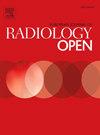Pediatric gonadal torsion in radiology: A comprehensive literature and pictorial review using surgically proven cases
IF 2.9
Q3 RADIOLOGY, NUCLEAR MEDICINE & MEDICAL IMAGING
引用次数: 0
Abstract
Pediatric gonadal torsion is a critical surgical emergency requiring immediate diagnosis and intervention to preserve reproductive capabilities. This review addresses the diagnostic challenges, imaging patterns, and management strategies for both ovarian and testicular torsion, including a brief discussion on the emerging role of Contrast-Enhanced Ultrasound (CEUS), therefore filling a significant gap in the literature. We emphasize the need for a high index of suspicion due to often nonspecific clinical presentations, particularly in ovarian torsion. An accurate and swift diagnosis allows conservative surgical intervention to be offered, which is crucial to maximize gonadal salvage and minimize recurrence. While we highlight CEUS's potential benefits in enhancing diagnostic clarity without ionizing radiation, ultrasound and other modalities such as MRI and CT, have a paramount role in this setting. Future research comparing CEUS with MRI is essential to validate its diagnostic accuracy and effectiveness, potentially revolutionizing acute care diagnostics. Incorporating CEUS into diagnostic workflows, along with a deep understanding of the condition's epidemiology, pathophysiology, and clinical presentation, may probably significantly improve patient outcomes. We detail the characteristic imaging features, diagnostic pitfalls, and differential diagnoses essential for radiologists, with particular relevance for residents and those with limited pediatric radiology exposure. This review aims to bridge existing knowledge gaps and serve as a robust educational tool, facilitating better clinical decision-making and outcomes in pediatric gonadal torsion cases.
儿科性腺扭转放射学:综合文献和图片回顾,使用手术证实的病例
小儿性腺扭转是一个关键的外科急诊需要立即诊断和干预,以保持生殖能力。本文综述了卵巢和睾丸扭转的诊断挑战、成像模式和管理策略,包括简要讨论了对比增强超声(CEUS)的新兴作用,从而填补了文献中的重大空白。我们强调需要高的怀疑指数,由于往往非特异性临床表现,特别是在卵巢扭转。准确和迅速的诊断可以提供保守的手术干预,这对于最大限度地挽救性腺和减少复发至关重要。虽然我们强调超声造影在没有电离辐射的情况下提高诊断清晰度的潜在好处,但超声和其他方式(如MRI和CT)在这种情况下发挥着至关重要的作用。未来的研究将超声造影与MRI进行比较,以验证其诊断的准确性和有效性,这可能会给急症诊断带来革命性的变化。将超声造影纳入诊断工作流程,并深入了解疾病的流行病学、病理生理学和临床表现,可能会显著改善患者的预后。我们详细介绍了放射科医生的特征成像特征、诊断陷阱和鉴别诊断,特别是与住院医生和那些有有限儿科放射暴露的人有关。本综述旨在弥合现有的知识差距,并作为一个强大的教育工具,促进更好的临床决策和结果在儿童性腺扭转的情况下。
本文章由计算机程序翻译,如有差异,请以英文原文为准。
求助全文
约1分钟内获得全文
求助全文
来源期刊

European Journal of Radiology Open
Medicine-Radiology, Nuclear Medicine and Imaging
CiteScore
4.10
自引率
5.00%
发文量
55
审稿时长
51 days
 求助内容:
求助内容: 应助结果提醒方式:
应助结果提醒方式:


